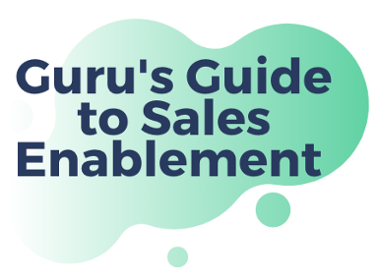How to Be an Effective Sales Enablement Professional
価値ある会話よりもコンテンツに焦点を当てることで、営業支援の実践は営業担当者が実際の収益を生むのに役立つことができないままでいます。
2019年11月更新。
2018年に営業会議に出席し、信頼できるCROに「コンテンツが営業の支援を死なせた」と宣言しました。 説明する前に、彼は「あなたは最初からそれが生きていたと仮定しています」と返事をしました。
これが良い出発点のように感じますね? だからここから始めましょう:営業支援とは一体何を意味するのか?
それは直感的な質問のように思えるかもしれませんが、もし営業支援の専門家に営業支援が実際に何であるかを尋ねると、あなたは非常に異なった三つの答えを得ることになるでしょう。 定義をグーグルすると、ベンダーSEOがプロパガンダで溢れます。
多くの年を営業支援の役割で過ごした者として、数ヶ月前にすべての混乱の源を理解しようと決意して座りました。 営業支援のリーダーや高パフォーマンスの営業担当者と広範囲にわたって話をした後、私は次のことを発見しました:
営業支援は急成長を遂げています
CSOインサイトが実施した2017年の営業組織に関する調査によると、回答者の59%が専任の営業支援機能を持っていました。 その数字は2013年のわずか19%から上昇しており、その機能自体が急成長していることを示しています。 営業支援がいかに「熱い」かをさらに示すために、現在Indeed.comには2,800件以上の営業支援の求人が掲載されており、営業支援技術とプログラムへの総合的な投資が急増しています。
それがどれほど急増しているかを理解するために、年間660億ドル以上が営業研修と営業支援技術に費やされています。
営業支援の進化する状態に関するコンテンツをもっと探していますか? 新しく公開されたガイドをチェックしてください:
営業支援の成長は、営業担当者がより良いパフォーマンスを発揮していることを意味しますか?
営業支援へのすべての投資を考えると、営業担当者が全体としてより高いパフォーマンスを発揮していると仮定するのは安全でしょうか? そして、営業担当者のパフォーマンス目標が最終的には収益を上げることであるならば、私たちはより高い目標達成率を見るべきであるはずです。
実際、答えは明確に「いいえ」です。 データはかなり厳しい現実を示しています:
- 調査対象者の77%は営業担当者が自社の価値を見込み客に理解していないと言っています。
- 71%の営業担当者は取引を進めるための十分な知識がないと言っています。
- わずか58%の営業担当者が目標を達成しています。
では、ここでのギャップは一体何なのでしょうか? なぜ誰も営業支援を簡潔かつ一貫して定義できないのでしょうか? なぜ営業担当者は一貫して目標を達成できず、収益を上げることができないのでしょうか?
これらの質問への答えは、実際には私が信じていたよりもはるかに単純です。 私が見つけた営業支援の定義の中で、フォレスターのものが最も興味深いかもしれません:
営業支援は、すべての顧客対応の従業員に価値ある会話を一貫して系統的に行う能力を身につけさせる戦略的で継続的なプロセスです。
この定義の特に興味深い点は、会話への強調です。 もし目標が営業担当者に価値ある会話を持つ能力を備えさせることであるなら、なぜほとんどの「営業支援」ツールはマーケティングコンテンツに焦点を当てているのでしょうか?
営業支援とコンテンツの関係は何ですか?
営業支援の混乱の中で、膨大な数のM&A活動と統合がありました。 2009年に設立されたClearslideは、1985年に設立されたCoralに買収されました。 2012年に設立されたDocuratedは、1981年に設立されたQuarkに買収されました。 2006年に設立されたKnowledge Treeは、1999年に設立されたSAVOに買収され、その後2010年にSeismicに買収されました。 これらの企業がプロダクト市場適合の維持に苦労する中で、これらの企業が設立されたときから営業にどれだけの変化があったのかを問わざるを得ません。
答えは:たくさんです。
今日のB2B営業サイクルは、買い手と売り手の両方にとって複雑です。 標準的な購買委員会には平均6人が関与し、競争もこれまで以上に激しくなっているため、エンゲージメントを維持し、営業サイクルのスピードを上げ、コンサルティング的な営業を行うことがこれまで以上に重要です。
加えて、近年、ライブチャットアプリケーションの爆発的な増加がありました。 これらのツール、例えばIntercom、Drift、Hubspot、Conversicaなどは、営業担当者と話をし、ソフトウェアを購入するのを簡単にすることを目的としています。
私たちの顧客は、微妙な質問を持って私たちのもとに訪れ、リアルタイムの回答を期待しています。 静的で反応的な営業の日々は終わりました。 物事はこれまで以上にダイナミックでリアルタイムであり、営業支援は単に追いついていません。
「営業は進化しています。なぜなら、顧客の旅は無限のループだからです。 今日の顧客は、顧客の旅の中で関わるすべての人が、営業前後を問わず、同じレベルのサービスと知識を提供できることを期待しています。 彼らは、あなたの会社の誰の役職に関係なく、営業前か営業後かを気にしていません。 彼らは、必要なときに必要なものを提供してくれるすべての人を期待しており、同じレベルのサービスと専門知識を常に求めています。」 - Roz Greenfield, Level213の最高営業支援責任者で、以前はOptimizelyのグローバル営業支援責任者でした。
では、これがすべて何に集約されるのでしょうか? エンゲージメントと注意が売り手にとって最も貴重な資源である場合、見込み客との会話は重要な瞬間です。
- 売り手が競合について問いかけられ、答えがない場合、競合がその物語を支配し、勝率が下がるリスクがあります。
- 売り手が重要なセキュリティ要件について問いかけられ、答えを知っている自信がない場合、買い手を frustrate し、会話を止め、営業サイクルが長引く。」,
- 売り手が特定のユースケースについて問いかけられ、すぐに顧客のストーリーを言うことができない場合、買い手の注意を引きつけ、製品の価値を強化する能力を失います。さらに、平均販売価格(ASP)に影響を与える可能性があります。
- 売り手がセキュリティやコンプライアンスに関する予測できない質問をされ、その場で答えられない場合、信頼性や信頼性を失い、勢いを失い、最終的には競合に取引を失うことになります。
営業支援を考えるとき、私たちは成果の観点で考えなければなりません。 収益の組織として、私たちは勝率、ASP、営業速度に関心を持っています。 ケーススタディやホワイトペーパーのような外部コンテンツも重要ですが、あまりにもマーケティング資産に重点を置いた営業支援ソリューションは、営業問題ではなくマーケティング問題を解決するだけです。 これらの質問への答えは、営業担当者が収益を生み出す助けにはなりません。
期間。 営業支援は、見込み客に提示して送付する営業資産にとどまりません。 それらは、今日のビジネスを締結するために必要なリアルタイムの会話を促進する助けにはなりません。 「私にとって、営業支援はマーケティング用語です。
営業担当者を支援するための情報資産や知識を提供されるとき、私はあなたを営業担当者に特に役立てていると思います。 それは営業担当者のためのマーケティング機能です。」 - Doug Landis, Emergence Capitalの成長パートナー - ダグ・ランディス、エマージェンス・キャピタルの成長パートナー
営業担当者は、リアルタイムで異議を唱え、セキュリティの専門知識を持つように権限を与えられ、商品、市場、買い手についてコンサルタントとして会話を進めることができる能力を持つ必要があります。
商談の前または後に見込み客にワンシートまたはPDFを送信することは可能でしょうか? はい、 しかし、営業支援の未来は、売り手が価値あるリアルタイムの会話を持つことを可能にすることです。
営業支援を使用して、営業担当者がより良い会話を持つようにすること
顧客対応チームが一致し、継続的な知識と専門知識にアクセスできる場合、彼らは収益を生み出す貴重な会話を持つ能力を持つことができます。 営業はかつてないほど会話に重視されているという実情を受け入れ、見込み客とのリアルタイムの会話に参加しているときは、その会話を促進し、すべてのステップで価値を追加していることを確認する必要があります。
2019年11月更新。
2018年に営業会議に出席し、信頼できるCROに「コンテンツが営業の支援を死なせた」と宣言しました。 説明する前に、彼は「あなたは最初からそれが生きていたと仮定しています」と返事をしました。
これが良い出発点のように感じますね? だからここから始めましょう:営業支援とは一体何を意味するのか?
それは直感的な質問のように思えるかもしれませんが、もし営業支援の専門家に営業支援が実際に何であるかを尋ねると、あなたは非常に異なった三つの答えを得ることになるでしょう。 定義をグーグルすると、ベンダーSEOがプロパガンダで溢れます。
多くの年を営業支援の役割で過ごした者として、数ヶ月前にすべての混乱の源を理解しようと決意して座りました。 営業支援のリーダーや高パフォーマンスの営業担当者と広範囲にわたって話をした後、私は次のことを発見しました:
営業支援は急成長を遂げています
CSOインサイトが実施した2017年の営業組織に関する調査によると、回答者の59%が専任の営業支援機能を持っていました。 その数字は2013年のわずか19%から上昇しており、その機能自体が急成長していることを示しています。 営業支援がいかに「熱い」かをさらに示すために、現在Indeed.comには2,800件以上の営業支援の求人が掲載されており、営業支援技術とプログラムへの総合的な投資が急増しています。
それがどれほど急増しているかを理解するために、年間660億ドル以上が営業研修と営業支援技術に費やされています。
営業支援の進化する状態に関するコンテンツをもっと探していますか? 新しく公開されたガイドをチェックしてください:
営業支援の成長は、営業担当者がより良いパフォーマンスを発揮していることを意味しますか?
営業支援へのすべての投資を考えると、営業担当者が全体としてより高いパフォーマンスを発揮していると仮定するのは安全でしょうか? そして、営業担当者のパフォーマンス目標が最終的には収益を上げることであるならば、私たちはより高い目標達成率を見るべきであるはずです。
実際、答えは明確に「いいえ」です。 データはかなり厳しい現実を示しています:
- 調査対象者の77%は営業担当者が自社の価値を見込み客に理解していないと言っています。
- 71%の営業担当者は取引を進めるための十分な知識がないと言っています。
- わずか58%の営業担当者が目標を達成しています。
では、ここでのギャップは一体何なのでしょうか? なぜ誰も営業支援を簡潔かつ一貫して定義できないのでしょうか? なぜ営業担当者は一貫して目標を達成できず、収益を上げることができないのでしょうか?
これらの質問への答えは、実際には私が信じていたよりもはるかに単純です。 私が見つけた営業支援の定義の中で、フォレスターのものが最も興味深いかもしれません:
営業支援は、すべての顧客対応の従業員に価値ある会話を一貫して系統的に行う能力を身につけさせる戦略的で継続的なプロセスです。
この定義の特に興味深い点は、会話への強調です。 もし目標が営業担当者に価値ある会話を持つ能力を備えさせることであるなら、なぜほとんどの「営業支援」ツールはマーケティングコンテンツに焦点を当てているのでしょうか?
営業支援とコンテンツの関係は何ですか?
営業支援の混乱の中で、膨大な数のM&A活動と統合がありました。 2009年に設立されたClearslideは、1985年に設立されたCoralに買収されました。 2012年に設立されたDocuratedは、1981年に設立されたQuarkに買収されました。 2006年に設立されたKnowledge Treeは、1999年に設立されたSAVOに買収され、その後2010年にSeismicに買収されました。 これらの企業がプロダクト市場適合の維持に苦労する中で、これらの企業が設立されたときから営業にどれだけの変化があったのかを問わざるを得ません。
答えは:たくさんです。
今日のB2B営業サイクルは、買い手と売り手の両方にとって複雑です。 標準的な購買委員会には平均6人が関与し、競争もこれまで以上に激しくなっているため、エンゲージメントを維持し、営業サイクルのスピードを上げ、コンサルティング的な営業を行うことがこれまで以上に重要です。
加えて、近年、ライブチャットアプリケーションの爆発的な増加がありました。 これらのツール、例えばIntercom、Drift、Hubspot、Conversicaなどは、営業担当者と話をし、ソフトウェアを購入するのを簡単にすることを目的としています。
私たちの顧客は、微妙な質問を持って私たちのもとに訪れ、リアルタイムの回答を期待しています。 静的で反応的な営業の日々は終わりました。 物事はこれまで以上にダイナミックでリアルタイムであり、営業支援は単に追いついていません。
「営業は進化しています。なぜなら、顧客の旅は無限のループだからです。 今日の顧客は、顧客の旅の中で関わるすべての人が、営業前後を問わず、同じレベルのサービスと知識を提供できることを期待しています。 彼らは、あなたの会社の誰の役職に関係なく、営業前か営業後かを気にしていません。 彼らは、必要なときに必要なものを提供してくれるすべての人を期待しており、同じレベルのサービスと専門知識を常に求めています。」 - Roz Greenfield, Level213の最高営業支援責任者で、以前はOptimizelyのグローバル営業支援責任者でした。
では、これがすべて何に集約されるのでしょうか? エンゲージメントと注意が売り手にとって最も貴重な資源である場合、見込み客との会話は重要な瞬間です。
- 売り手が競合について問いかけられ、答えがない場合、競合がその物語を支配し、勝率が下がるリスクがあります。
- 売り手が重要なセキュリティ要件について問いかけられ、答えを知っている自信がない場合、買い手を frustrate し、会話を止め、営業サイクルが長引く。」,
- 売り手が特定のユースケースについて問いかけられ、すぐに顧客のストーリーを言うことができない場合、買い手の注意を引きつけ、製品の価値を強化する能力を失います。さらに、平均販売価格(ASP)に影響を与える可能性があります。
- 売り手がセキュリティやコンプライアンスに関する予測できない質問をされ、その場で答えられない場合、信頼性や信頼性を失い、勢いを失い、最終的には競合に取引を失うことになります。
営業支援を考えるとき、私たちは成果の観点で考えなければなりません。 収益の組織として、私たちは勝率、ASP、営業速度に関心を持っています。 ケーススタディやホワイトペーパーのような外部コンテンツも重要ですが、あまりにもマーケティング資産に重点を置いた営業支援ソリューションは、営業問題ではなくマーケティング問題を解決するだけです。 これらの質問への答えは、営業担当者が収益を生み出す助けにはなりません。
期間。 営業支援は、見込み客に提示して送付する営業資産にとどまりません。 それらは、今日のビジネスを締結するために必要なリアルタイムの会話を促進する助けにはなりません。 「私にとって、営業支援はマーケティング用語です。
営業担当者を支援するための情報資産や知識を提供されるとき、私はあなたを営業担当者に特に役立てていると思います。 それは営業担当者のためのマーケティング機能です。」 - Doug Landis, Emergence Capitalの成長パートナー - ダグ・ランディス、エマージェンス・キャピタルの成長パートナー
営業担当者は、リアルタイムで異議を唱え、セキュリティの専門知識を持つように権限を与えられ、商品、市場、買い手についてコンサルタントとして会話を進めることができる能力を持つ必要があります。
商談の前または後に見込み客にワンシートまたはPDFを送信することは可能でしょうか? はい、 しかし、営業支援の未来は、売り手が価値あるリアルタイムの会話を持つことを可能にすることです。
営業支援を使用して、営業担当者がより良い会話を持つようにすること
顧客対応チームが一致し、継続的な知識と専門知識にアクセスできる場合、彼らは収益を生み出す貴重な会話を持つ能力を持つことができます。 営業はかつてないほど会話に重視されているという実情を受け入れ、見込み客とのリアルタイムの会話に参加しているときは、その会話を促進し、すべてのステップで価値を追加していることを確認する必要があります。
Experience the power of the Guru platform firsthand – take our interactive product tour
見学する







